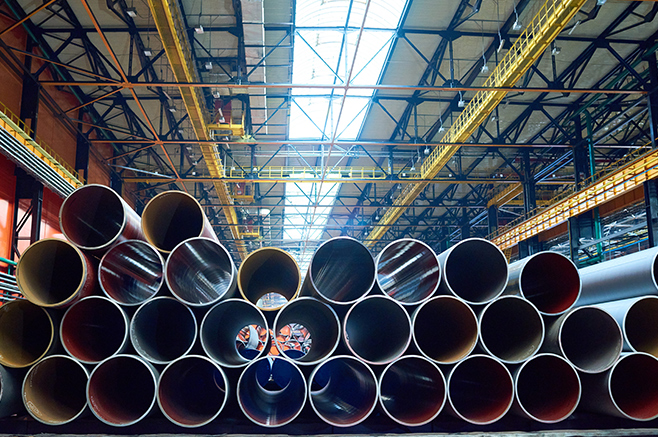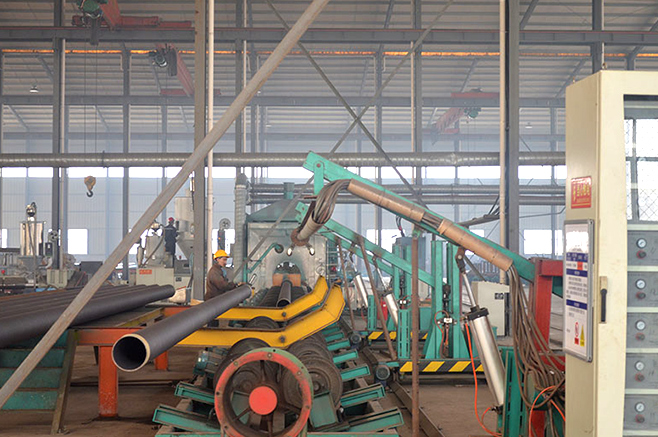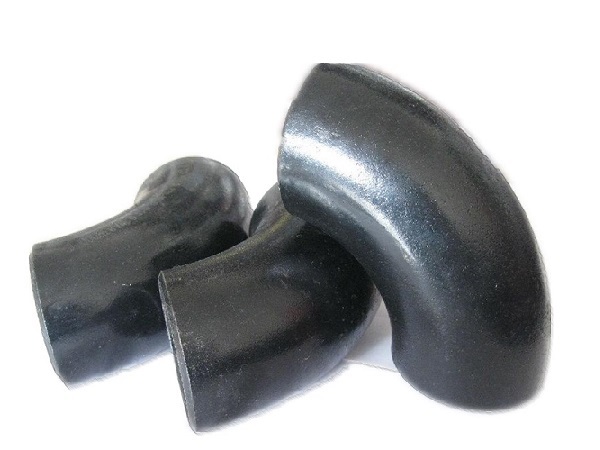Pipe elbows
Pipe elbows are used to be installed between two lengths of pipe or tube allowing a change of direction,usually these elbows distinguished by connection ends.
What’s a pipe elbows?
Steel pipe elbow (sometimes also refereed as bends) is a key part in a pressure piping system used to change the fluid flow direction. It is used to connect two pipes with same or different nominal diameters, and to make the pipe and thus the fluid direction turn to a certain direction of 45 degree or 90 degree.
Classification of Steel Pipe Elbows
Steel pipe elbows can be classified through following various parameters,
· Direction Angle
· Length and Radius
· Connection with Pipe
· Material of Construction
Types of Elbows based on Direction Angle
According to fluid flow direction of the pipes, elbows can be divided into different degrees, such as 45 degree, 90 degree, 180 degree, which are most common elbows. Also there are 60 degree and 120 degree elbows for some special pipelines. This degree is just an representation of the angle by which the fluid flow is going to change after flowing through the said elbow.
Types of Elbows based on Length and Radius
Elbows are split into two groups which define the distance over which the flowing fluid change direction; the center line of one end to the opposite face. This is known as the “Center to Face” distance and is equivalent to the radius through which the elbow is bent.
If the radius is the same as pipe diameter (Center-to-Face dimension of 1.0 X diameter ), it called Short Radius Elbow (SR elbow) used normally for low pressure and low speed pipelines or in tight areas where clearance is the main issue. If the radius is larger than pipe diameter (Center-to-Face dimension of 1.5 X diameter) then we call it a Long Radius Elbow (LR Elbow) used for high pressure and high flow rate pipelines.
Long Radius Elbow VS Short Radius Elbow
The elbow is divided into its radius of curvature and can be divided into a long radius elbow and a short radius elbow. The long radius elbow refers to the outer diameter of the tube whose radius of curvature is equal to 1.5 times, that is, R = 1.5D. A short radius elbow means that its radius of curvature is equal to the outer diameter of the tube, ie R = D. Where D is the diameter of the elbow and R is the radius of curvature. Normal use of the length of the radius Sometimes to reduce the loss of resistance or elbow wear, the elbow with a larger bending radius will be used (in fact, it is not called elbow); when there is a limit on the installation position, a short radius elbow will be used.
When to choose a long radius elbow or a short radius elbow?
There are two types of pipe sizes for process installation, namely pipe outer diameter and nominal size. D, DN, refers to the nominal size of the pipe. It does not represent the inner diameter of the pipe or the outer diameter of the pipe. It is a nominal size designed and used. The elbow is the elbow, and the manufacturing method is divided into the push elbow, the extrusion elbow and the welded miter elbow. The structure length is 1.0D, 1.5D, 2.0D.
At present, there are two kinds of norms implemented in this area in China: metric and imperial. For example: 1.5D steel seamless elbow, DN100 outer diameter ¢108 and ¢114.3, actual structural length L152, DN200 outer diameter ¢219 and ¢216.3, actual structural length L302. In use, long radius elbow (R = 15DN): in general, should be preferred; short radius elbow (R = 1.0DN): mostly used in applications where size is limited. Its high working pressure should not exceed 0.8 times of the long radius elbow of the same specification.
Elbow (R=nDN): used to moderate the scouring and kinetic energy of the media at the bend, available to R=3DN, 6DN, 10DN, 20DN. According to different manufacturing methods, it is divided into push elbow, extrusion elbow and welded miter elbow.
Pushing elbows and extrusion elbows: Commonly used for welding mitered elbows on medium and small-sized pipes with strict media conditions: It is often used on large-sized pipes with moderate media conditions, and the bending radius is not to be less than its nominal diameter. 1.5 times. When the miter angle of the miter elbow is greater than 450, it should not be used on highly toxic, flammable medium pipes, or on pipes subjected to mechanical vibration, pressure pulsation and alternating load due to temperature changes.
So how do we buy qualified elbows? Detecting the back arc of the elbow: Seamless elbow detection of the thickness of the back arc is an important task. Many large pipe elbow manufacturers or strict engineering inspection of the back arc is a must. It is related to the safety and stability of the pipeline operation.
Everyone knows that both the seamless steel pipe and the seamless elbow are under pressure, that is, the pressure is very large when running. Under normal circumstances, the safety factor of the thickness of the seamless elbow designed and installed is about six times. For example, the 219*8 seamless elbow, the pipeline medium is ordinary water, the temperature is usually not higher than one hundred degrees Celsius, and the pressure required to blast such a seamless elbow is about 300 kg, that is to say, The pressure inside the pipeline needs to reach PN30, and the seamless elbow will be blasted, and the operating pressure of this elbow is probably about it. It is estimated that the maximum will not exceed PN6.4, which is generally around PN4.0, of course. With the corrosion of the pipeline, the seamless elbow will also be corroded to varying degrees. In order to ensure its safe operation, the necessity of overhaul is also great.
The current process of making seamless elbows will lead to the phenomenon of back arc thinning. Under normal circumstances, the wall thickness of the mouth will be about two millimeters thinner than the back arc. The common thickness and pressure are not thinner even if the back arc is thinned. There will be too many safety hazards, because the elbow has not been replaced until the elbow has a dangerous accident. But as a rigorous project, what is not the same, and the medium inside the pipeline is also responsible, not just water. There may be oil or other impurities, the temperature is high and the pressure is high, and the thickness of the back arc as the weak place determines the life of the seamless elbow. Therefore, the importance of detecting the back arc is naturally great. With the thickness gauge, read the thickness of a point at the elbow directly.
What does Short Radius (SR) or Long Radius (LR) means?
You will often hear SR45 elbow or LR45 elbow. The 45 or 90 refers to the angle of the bend for buttweld fitting to change the direction of flow. A long radius elbow (LR 90 Elbow or LR 45 elbow) will have a pipe bend that will be 1.5 times the size of the pipe. So, a 6 inch LR 90 has bending radius that is 1.5 x nominal pipe size. A short radius elbow (SR45 or SR90) has a pipe bend that is equal to the size of the fitting, so a 6” SR 45 has a bending radius that is 6” nominal pipe size.
What is a 3R or 3D elbow pipe fitting?
First, the terms 3R or 3D are used synonymously. A 3R butt weld elbow has a bending radius that is 3 times the nominal pipe size. A 3R elbow is smoother than SR or LR fitting.
Types of Elbows based on Connection with Pipe
As per the connection with pipe, elbows could be classified as Butt Welded Elbow, Socket Welded Elbow and Threaded Elbow.
Butt Welded Elbow
Butt weld elbow is a steel elbow formed by hot pressing or forging. Its connection form is to directly weld the elbow and steel pipe. Butt welded elbows have beveled ends to allow for ease of welding. This bevel allows for full penetration weld in most of the cases. Butt welded elbows are mainly used for elbow with higher pressure and temperature.
Socket Welded Elbow
Socket weld elbow is also welded to the pipe and fittings end. Unlike the butt weld elbow, the socket weld elbow has a trapezoidal area at the end. We can insert pipe end into this area (the diameter of SW elbow is matched with the outer diameter of pipe), then do welding work to connect them together. Therefore, the actual diameter of SW elbow end is greater than the elbow diameter.
Threaded Elbow
The shape of threaded elbow is similar to the SW elbow, except that the inner surface of the trapezoidal area has been machined into thread. It is easier to install and remove, good for pipeline repair and maintenance.
Types of Elbows based on Material of Construction
Stainless Steel Elbow : ASTM A403 WP Gr. 304, 304H, 309, 310, 316, 316L, 317L, 321, 347, 904L
Carbon Steel Elbow : ASTM A 234 WPB , WPBW, WPHY 42, WPHY 46, WPHY 52, WPH 60, WPHY 65 & WPHY 70.
Low Temperature Carbon Steel Elbow : ASTM A420 WPL3, A420 WPL6
Alloy Steel Elbow : ASTM / ASME A/SA 234 Gr. WP 1, WP 5, WP 9, WP 11, WP 12, WP 22, WP 91
Duplex Steel Elbow : ASTM A 815, ASME SA 815 UNS NO S31803, S32205. Werkstoff No. 1.4462
Nickel Alloy Elbow : ASTM / ASME SB 336 UNS 2200 ( NICKEL 200 ), UNS 2201 (NICKEL 201 ), UNS 4400 (MONEL 400 ), UNS 8020 ( ALLOY 20 / 20 CB 3, UNS 8825 INCONEL (825), UNS 6600 (INCONEL 600 ), UNS 6601 ( INCONEL 601 ), UNS 6625 (INCONEL 625), UNS 10276 ( HASTELLOY C 276 )
Some Other Types of Elbows
In addition to the above defined elbows there are few more types of elbows which are not used on regular basis. Few of them has been defined below.
Reducing Elbow
A reducing elbow is a type of fitting which is used to join two pipes of different sizes. The reducing elbow is so called because it looks like a reducing piece and elbow combined into one. The reducing elbow eliminates one pipe fitting (reducer) and reduces the welding by more than one-third. Also, the gradual reduction in diameter throughout the arc of the reducing elbow provides lower resistance to flow and reduces the effect of stream turbulence and potential internal erosion. These features prevent sizable pressure drops in the line.
For many suppliers it is a non standard item resulting into high price with a long delivery time. The use of a “normal” elbow with a separate reducer is an option if the situation allows.
Male Pipe Elbows & Female Pipe Elbows
Male pipe elbows and female pipe elbows are popular tube fittings which provide an fluid flow directional change of a tubing run. While a male pipe elbow is used to connect fractional tube to female tapered pipe thread, a female elbow is used to connect fractional tube to male NPT thread. These types of tube fittings like male elbows and female elbows have been specifically designed for use on instrumentation, process and control systems and equipment employed in chemical, petroleum, fluid power, electronic and pulp and paper plants.
Wall Thickness of Elbows
The weakest point on an elbow is the inside radius. ASME B16.9 only standardizes the center to face dimensions and some “squareness” dimensional tolerances. The wall thickness at the weld line location even is standardized, but not through the rest of an elbow. The standard states that the minimum tolerance will be within 12.5% of the minimum ordered wall thickness of the pipe. A maximum tolerance is specified only at the ends of the fitting. Many providers of butt weld elbows provide one schedule greater thickness so that sufficient wall thickness, after forming, remains.

- Telphone- 0317-6689999
- E-mail- zhongran@zrpiping.com
- Address- Yanshan County Industrial Park, Cangzhou City, Hebei Province
- Telphone- 0317-6689999
- E-mail- zhongran@zrpiping.com
- Address- Yanshan County Industrial Park, Cangzhou City, Hebei Province
Copyright:Hebei Zhongran Pipefitting Co., Ltd. 冀ICP备19004948号-6








